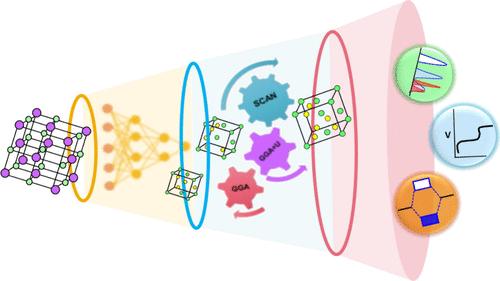通过第一原理计算揭示富 Na 阴极材料中阳离子和阴离子氧化还原作用的贡献
IF 4.3
3区 材料科学
Q1 ENGINEERING, ELECTRICAL & ELECTRONIC
引用次数: 0
摘要
钠离子电池(SIB)的低比容量限制了其在大容量储能设备中的实际应用。最近,阳离子和阴离子累积氧化还原反应被认为是实现钠离子电池高容量的可行方法。然而,在阴离子氧化还原过程中,易氧化氧的过量氧化会导致富含 Na 的阴极材料的结构退化和电压滞后。在这项工作中,我们采用第一原理密度泛函理论(DFT)计算,阐明了富纳阴极材料(Na2RuO3)原型在不同电压窗口下阳离子和阴离子氧化还原反应的贡献。此外,我们还利用机器学习原子间电位(MLIPs)、CHGNet 和 MACE-MP-0 来说明 Na2RuO3 在不同程度脱插时的相变。为了了解这种材料的氧化还原化学性质,我们研究了其电子结构、O2 结合能、键共价和局部磁矩。我们的研究表明,在工作窗口内的所有电压范围内,强约束和适当规范(SCAN)函数都优于 PBE 和 PBE + U 方法。此外,我们利用 SCAN 函数计算的电化学势与现有的实验数据一致。此外,通过加入一系列 Hubbard U 值(U = 2、4、5 eV),我们强调了根据相关元素选择合适 U 参数的重要性和准确性。我们的研究结果表明,尽管 Na2RuO3 是一种富含 Na 的材料,但阳离子氧化还原主要占主导地位。此外,我们还证明了 CHGNet 和 MACE-MP-0 MLIPs 可以有效地用于预筛选富含 Na 的阴极材料,其电化学特性具有合理的准确性。本文章由计算机程序翻译,如有差异,请以英文原文为准。

Unraveling the Contribution of Cationic and Anionic Redox in Na-Rich Cathode Materials through First-Principles Calculations
The low specific capacity of sodium-ion batteries (SIBs) limits their practical use in high-capacity energy storage devices. Recently, cumulative cationic and anionic redox reactions have been identified as promising approaches to achieving high capacity in SIBs. However, the excess oxidation of labile oxygen during anionic redox leads to structural degradation and voltage hysteresis in Na-rich cathode materials. In this work, we employ first-principles density functional theory (DFT) calculations to elucidate the contributions of cationic and anionic redox reactions in a prototype Na-rich cathode material (Na2RuO3) across different voltage windows. Additionally, we utilized machine learning interatomic potentials (MLIPs), CHGNet and MACE-MP-0, to illustrate the phase transitions at varying degrees of deintercalation in Na2RuO3. To understand the redox chemistry of this material, we investigated the electronic structures, the O2 binding energies, the bond covalency, and the local magnetic moments. Our study demonstrates that the strongly constrained and appropriately normed (SCAN) functional outperforms PBE and PBE + U methods across all voltage ranges within the operating window. Furthermore, our computed electrochemical potentials with the SCAN functional are in agreement with the available experimental data. Additionally, by incorporating a series of Hubbard U values (U = 2, 4, 5 eV), we highlight the importance and accuracy of suitable U parameters depending on the element of interest. Our results indicate that in Na2RuO3, cationic redox is primarily dominant despite it being a Na-rich material. Moreover, we demonstrate that CHGNet and MACE-MP-0 MLIPs can be effectively used to prescreen Na-rich cathode materials with reasonable accuracy for their electrochemical properties.
求助全文
通过发布文献求助,成功后即可免费获取论文全文。
去求助
来源期刊

ACS Applied Electronic Materials
Multiple-
CiteScore
7.20
自引率
4.30%
发文量
567
期刊介绍:
ACS Applied Electronic Materials is an interdisciplinary journal publishing original research covering all aspects of electronic materials. The journal is devoted to reports of new and original experimental and theoretical research of an applied nature that integrate knowledge in the areas of materials science, engineering, optics, physics, and chemistry into important applications of electronic materials. Sample research topics that span the journal's scope are inorganic, organic, ionic and polymeric materials with properties that include conducting, semiconducting, superconducting, insulating, dielectric, magnetic, optoelectronic, piezoelectric, ferroelectric and thermoelectric.
Indexed/Abstracted:
Web of Science SCIE
Scopus
CAS
INSPEC
Portico
 求助内容:
求助内容: 应助结果提醒方式:
应助结果提醒方式:


